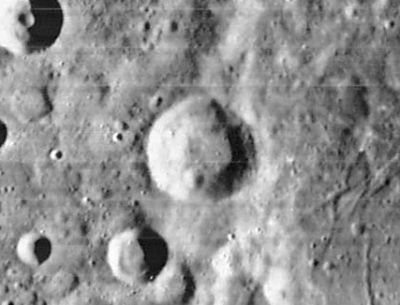Difference between revisions of "Lockyer"
| (2 intermediate revisions by the same user not shown) | |||
| Line 5: | Line 5: | ||
|} | |} | ||
<div id="toc"> | <div id="toc"> | ||
| − | + | [http://www.lpod.org/coppermine/displayimage.php?pid=2033&fullsize=1 [[Image:Normal_Lockyer_LO_iv_076_h2.jpg|external image normal_Lockyer_LO_iv_076_h2.jpg]]]<br /> ''[http://lpod.org/coppermine/displayimage.php?pos=-2033 LOIV 076 H2]''<br /> <br /> | |
| − | |||
==Images== | ==Images== | ||
| − | [http://www.lpod.org/coppermine/thumbnails.php?album=search&type=full&search=Lockyer LPOD Photo Gallery] [http://www.lpi.usra.edu/resources/lunar_orbiter/bin/srch_nam.shtml?Lockyer%7C0 Lunar Orbiter Images]<br /> '''Lockyer G''', the crater in the top photograph's upper left corner (with pronounced central peak), is mentioned in the [http://lpod.wikispaces.com/October%2015%2C%202008 LPOD of october the 15th, 2008]. An interesting telescopic target!<span class="membersnap">- | + | [http://www.lpod.org/coppermine/thumbnails.php?album=search&type=full&search=Lockyer LPOD Photo Gallery] [http://www.lpi.usra.edu/resources/lunar_orbiter/bin/srch_nam.shtml?Lockyer%7C0 Lunar Orbiter Images]<br /> '''Lockyer G''', the crater in the top photograph's upper left corner (with pronounced central peak), is mentioned in the [http://lpod.wikispaces.com/October%2015%2C%202008 LPOD of october the 15th, 2008]. An interesting telescopic target!<span class="membersnap">- DannyCaes <small>Oct 16, 2008</small></span><br /> <br /> |
==Maps== | ==Maps== | ||
| − | ''([ | + | ''([[LAC%20zone|LAC zone]] 114D4)'' [http://www.lpi.usra.edu/resources/mapcatalog/LAC/lac114/ LAC map] [http://www.lpi.usra.edu/resources/mapcatalog/usgs/I694/ Geologic map]<br /> <br /> |
==Description== | ==Description== | ||
<br /> | <br /> | ||
==Description: Elger== | ==Description: Elger== | ||
| − | ''([ | + | ''([[IAU%20directions|IAU Directions]])'' LOCKYER.--A prominent deep ring-plain, 32 miles in diameter, with massive bright lofty walls, standing just outside the S.W. border of [[Janssen|Janssen]]. Schmidt shows a minute crater on the S. rim. I have seen a crater within, at the inner foot of the E. wall, and a central peak.<br /> <br /> |
==Description: Wikipedia== | ==Description: Wikipedia== | ||
[http://en.wikipedia.org/wiki/Lockyer_(crater) Lockyer]<br /> <br /> | [http://en.wikipedia.org/wiki/Lockyer_(crater) Lockyer]<br /> <br /> | ||
==Additional Information== | ==Additional Information== | ||
| − | Depth data from [ | + | Depth data from [[Kurt%20Fisher%20Crater%20Depths|Kurt Fisher database]]<br /> |
* Westfall, 2000: 1.53 km | * Westfall, 2000: 1.53 km | ||
* Viscardy, 1985: 3.7 km | * Viscardy, 1985: 3.7 km | ||
| Line 24: | Line 23: | ||
==Nomenclature== | ==Nomenclature== | ||
| − | * Sir [http://en.wikipedia.org/wiki/J._Norman_Lockyer Joseph Norman Lockyer] (May 17, 1836 – August 16, 1920) was an English scientist, astrophysicist and astronomer. Along with the French scientist Pierre [ | + | * Sir [http://en.wikipedia.org/wiki/J._Norman_Lockyer Joseph Norman Lockyer] (May 17, 1836 – August 16, 1920) was an English scientist, astrophysicist and astronomer. Along with the French scientist Pierre [[Janssen|Janssen]] he is credited with discovering the gas helium. A keen amateur astronomer with a particular interest in the sun, Lockyer eventually became director of the solar physics observatory in Kensington London. To facilitate the transmission of ideas between scientific disciplines, Lockyer established the general science journal [http://www.nature.com/nature/index.html Nature] in 1869. |
* Crater Lockyer H was called '''''Hill''''' by Hugh Percy Wilkins and Patrick Moore, but the I.A.U. did not accept that name. | * Crater Lockyer H was called '''''Hill''''' by Hugh Percy Wilkins and Patrick Moore, but the I.A.U. did not accept that name. | ||
* Hill was a contemporary English selenographer. | * Hill was a contemporary English selenographer. | ||
| − | * A curiosity: who was William J. S. Lockyer? See ''Lightning, Auroras, Nocturnal Lights, and related luminous phenomena'' (William R. Corliss, ''The Sourcebook Project'', 1982), at GLL2-R6, GLL2-R8, and GLL14-R3. <span class="membersnap">- | + | * A curiosity: who was William J. S. Lockyer? See ''Lightning, Auroras, Nocturnal Lights, and related luminous phenomena'' (William R. Corliss, ''The Sourcebook Project'', 1982), at GLL2-R6, GLL2-R8, and GLL14-R3. <span class="membersnap">- DannyCaes <small>Apr 15, 2015</small></span> |
<br /> | <br /> | ||
==LPOD Articles== | ==LPOD Articles== | ||
| Line 39: | Line 38: | ||
---- | ---- | ||
| − | + | </div> | |
Latest revision as of 02:01, 16 April 2018
Contents
Lockyer
| Lat: 46.2°S, Long: 36.7°E, Diam: 34 km, Depth: 1.53 km, Rükl: 67 |
Images
LPOD Photo Gallery Lunar Orbiter Images
Lockyer G, the crater in the top photograph's upper left corner (with pronounced central peak), is mentioned in the LPOD of october the 15th, 2008. An interesting telescopic target!- DannyCaes Oct 16, 2008
Maps
(LAC zone 114D4) LAC map Geologic map
Description
Description: Elger
(IAU Directions) LOCKYER.--A prominent deep ring-plain, 32 miles in diameter, with massive bright lofty walls, standing just outside the S.W. border of Janssen. Schmidt shows a minute crater on the S. rim. I have seen a crater within, at the inner foot of the E. wall, and a central peak.
Description: Wikipedia
Additional Information
Depth data from Kurt Fisher database
- Westfall, 2000: 1.53 km
- Viscardy, 1985: 3.7 km
Nomenclature
- Sir Joseph Norman Lockyer (May 17, 1836 – August 16, 1920) was an English scientist, astrophysicist and astronomer. Along with the French scientist Pierre Janssen he is credited with discovering the gas helium. A keen amateur astronomer with a particular interest in the sun, Lockyer eventually became director of the solar physics observatory in Kensington London. To facilitate the transmission of ideas between scientific disciplines, Lockyer established the general science journal Nature in 1869.
- Crater Lockyer H was called Hill by Hugh Percy Wilkins and Patrick Moore, but the I.A.U. did not accept that name.
- Hill was a contemporary English selenographer.
- A curiosity: who was William J. S. Lockyer? See Lightning, Auroras, Nocturnal Lights, and related luminous phenomena (William R. Corliss, The Sourcebook Project, 1982), at GLL2-R6, GLL2-R8, and GLL14-R3. - DannyCaes Apr 15, 2015
LPOD Articles
Blacky and Wispy. Hemispherical Peak (Lockyer G).
Bibliography
Lockyer H (Hill): THE MOON by H.P.Wilkins and Patrick Moore.
J. N. Lockyer in the Sourcebook Project (William R. Corliss)
- In Mysterious Universe, a handbook of astronomical anomalies (1979) :
- Page 379: The Canals of Mars (Walter E. Maunder, Knowledge, 1894).
